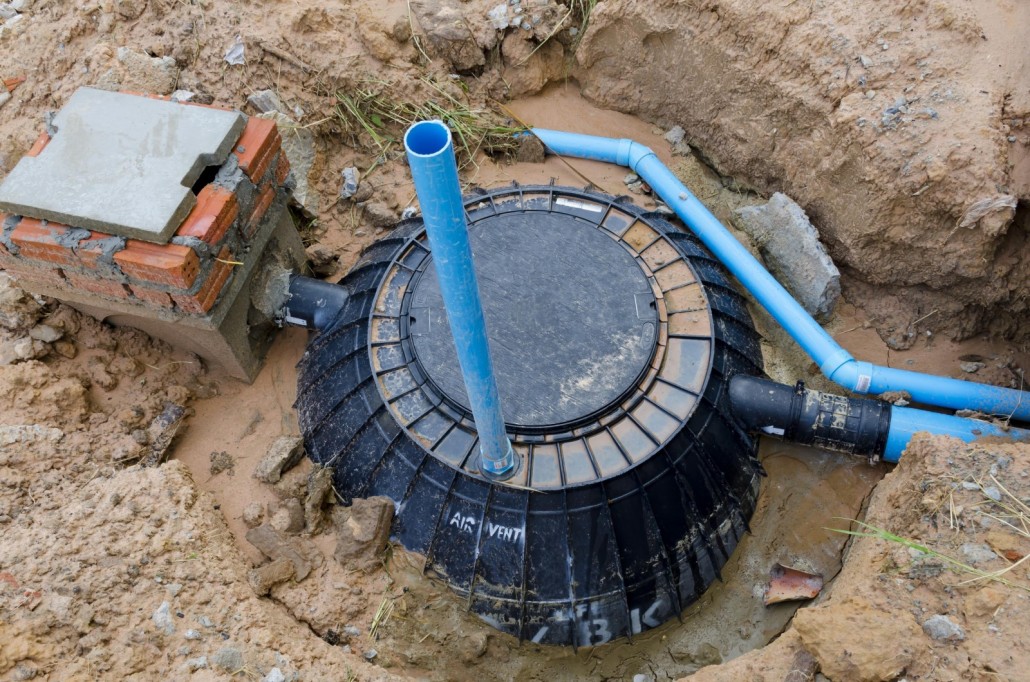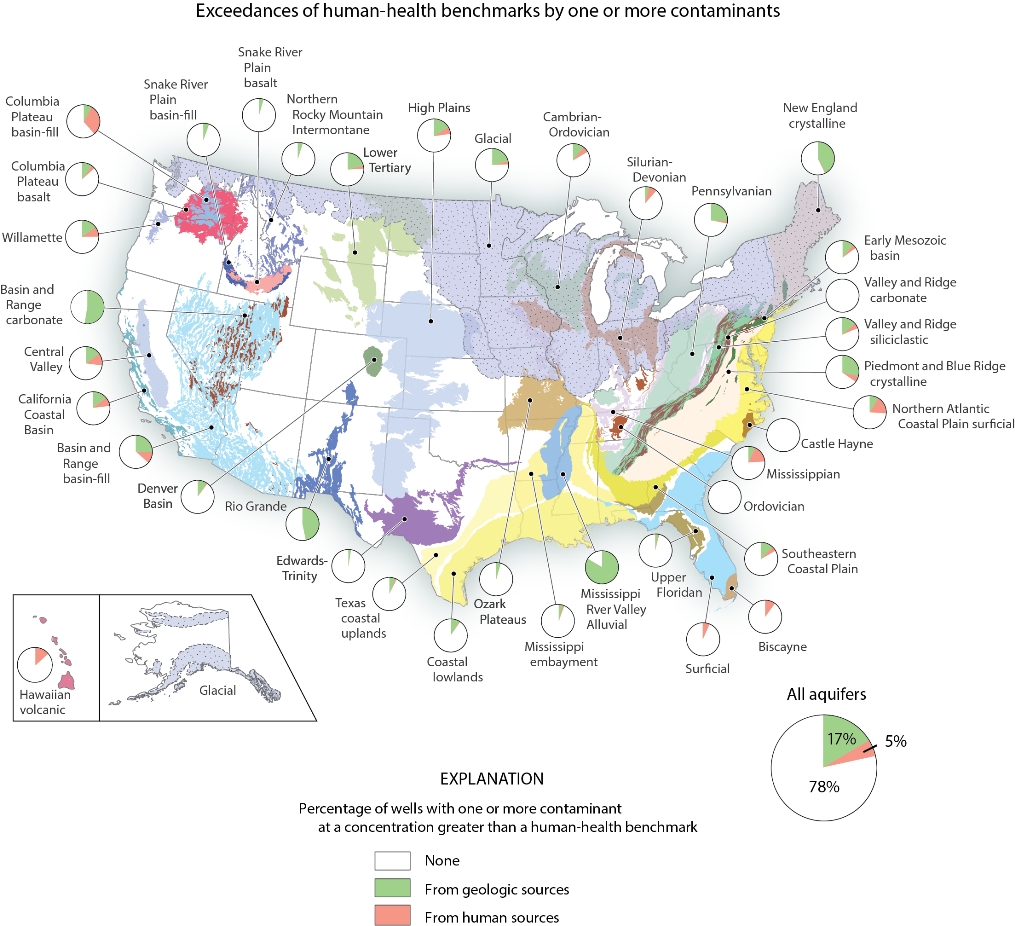America’s Septic System Failures Can Be Fixed
Solutions require new thinking about wastewater treatment

Basic septic systems are no more than a tank to trap solid waste and perforated piping that allows the liquid to seep into the soil. Evidence of environmental pollution and disease outbreaks have led to calls to modernize America’s septic systems. Photo courtesy of Shutterstock / TU Studio
By Brett Walton, Circle of Blue
Conceived as a low-cost, low-tech means of disposing toilet waste in rural communities without sewers, septic systems have become a leading cause of the toxic algae blooms that, like a rainbow cloak, drape across lakes, bays, and coastal shorelines on Cape Cod, Long Island, and small waterbodies in other states. As the top source of contamination for disease outbreaks from residential drinking water wells, septic systems also contribute to illness across the country.
The pollution of land and water is worsened by numerous factors: incomplete knowledge about the number and location of failing systems, old septic infrastructure that does not incorporate the latest nitrogen-removal technology, and an uneven application of pollution-reducing management practices.
In addition, changing environmental conditions will eventually produce new challenges. In wet regions, a warming planet may impair the soil’s capacity to cleanse liquid waste of microbial and nutrient contaminants.
In short, septic systems, used by one-fifth of U.S. households, mostly in New England, the Midwest, and the Deep South, need an upgrade.
“Septic has been successful for a long time, but we have to do better,” Joan Rose, director of Michigan State University’s Center for Advancing Microbial Risk Assessment, told Circle of Blue. “We’re adding more people. Systems are aging. The climate is changing. We have a long ways to go in assessment of nonpoint sources of pollution.”
Solutions do exist, but they require new research, investments, and policies. In certain cases, sanitation experts call for a drastic shift from individual backyard units to water-recycling, waste-reusing neighborhood systems that are cheaper than sewer expansions and match the 21st century ethic of resource efficiency.
In general, for septic systems to protect human health and ecosystems, public officials must improve three main areas: data, oversight, and design:
- Data — because authorities often do not have accurate maps of where septic systems are located or know where to target public funds.
- Oversight — because inadequate maintenance and upkeep is the primary cause of system failure.
- Design — because new technologies are required to remove nitrogen pollution and drive down costs.
Data: What You Don’t Know Can Hurt You
Not all of the nation’s 21.5 million household septic systems are malfunctioning. Many are properly maintained and contribute little to local water pollution. The problem is that officials do not know where to draw the line between the good and the bad. Also, small amounts of pollution, insignificant when discharged by a few systems, develop into a serious problem as the number of systems in an area increases.
Data gaps begin at the top. The U.S. Census Bureau estimates the number of septic systems nationally, but it stopped collecting data at the county level after 1980 because no federal agency regulates septic systems, according to spokeswoman Virginia Hyer. If they want detailed septic data, states and counties must collect it themselves.
A few are doing so. Georgia is developing WelSTROM, a GIS database of septic systems and drinking water wells, to help counties prevent water contamination. Data has been entered for 22 of Georgia’s 159 counties.
The Virginia Department of Health is using a bundle of economic, demographic, and septic data to identify “wastewater islands,” or areas with small lot sizes, no public sewer connection, poorly draining soils, older homes, and low household incomes. This combination of factors often indicates where septic systems are concentrated and at risk of failure.
“We’re looking at the environmental justice implications, where people have a lack of access to septic solutions,” Danna Revis, a training coordinator for the Virginia Office of Environmental Health Services, told Circle of Blue.
Revis said that the project, having started in the spring of 2015, is in its infancy, and she is not sure where it will lead. She hopes it helps the state pinpoint areas in need of public funding.
Oversight: New Rules Needed
Septic systems are not regulated by the federal Clean Water Act. Counties and states are in charge of writing the rules that govern septic system siting, installation, and upkeep. That division of responsibility results in a hodgepodge of regulatory programs of uneven strength, according to Craig Mains, an engineering scientist who studies septic systems with the National Environmental Services Center (NESC).
Take nitrogen, for example. Twenty-five states regulate the release of nitrogen from septic systems, according to a 2012 NESC survey. Only four have statewide requirements. For the others, the rules apply only in ecologically sensitive areas. Nitrogen, converted into nitrate in the soil, feeds algae blooms that wreck coastal ecosystems. If consumed at high enough doses, nitrates contribute to blood disorders in infants. Basic septic systems remove only 10 percent of the nitrogen in wastewater.
The U.S. Environmental Protection Agency does offer management guidance for local authorities. In 2003, the EPA published a set of voluntary guidelines for septic system oversight, identifying five basic management models that local agencies could adopt. The models form a spectrum. At one extreme is full reliance on the homeowner for repair and maintenance. At the other is the transfer of ownership of individual septic systems to local authorities which then assume responsibility for upkeep.
States with waterways in crisis because of nutrient pollution are taking steps to slash the amount of nitrogen coming from septic systems. Maryland, for example, passed the Chesapeake Bay Nitrogen Reduction Act in 2009, which requires the best available nitrogen removal technology be installed in new buildings and when old systems when are replaced. Other states could follow suit.
“Septic systems can work well if we give them proper care and treatment,” Theresa Connor, project development officer for Colorado State University’s One Water Solutions Institute, told Circle of Blue. “If we put them in the ground and ignore them, then we will have pollution problems.”
Design: Building a Better Tank
A basic septic system consists of a tank to trap solid waste and perforated piping to let the liquid percolate into the soil. In theory, soil microbes breakdown harmful bacteria and nutrients before they seep into groundwater, streams, or lakes.
Often that is not the case. Water-logged soil during wet periods prevents adequate treatment. Nitrogen is hardly removed at all. Over time, the soil’s treatment capacity diminishes as organic matter builds up.
Sewers are one solution, albeit an expensive one. Suffolk County, on Long Island, for instance, is spending $US 383 million from federal sources to connect just 10,000 homes in the most degraded watersheds to sewers. More than 1 million people use septic systems on Long Island, one of the densest concentrations of septic in the country.
But many suburban regions push back against sewer expansions, not only because of the cost. Some view them as a Trojan horse that will invite growth and development.
“The cost [of sewers] is high and the payback is low for utilities,” said Danny Johnson, manager of the Metro North Georgia Water Planning District, which covers 15 counties and 5 million people in the Atlanta region. “There was the expectation that we would phase out septic systems in subdivisions but that has not happened. Homeowners say, ‘I can’t pay that’ and it doesn’t get done.”
Other observers see similar dynamics at play in suburban growth.
“There’s a disconnect between environmental health concerns and the construction industry,” Laurel Standley, principal at Clear Current, a water pollution consultancy, told Circle of Blue. “It’s a policy failure, to be frank. We don’t have groups talking to each other, and it’s difficult to control development pressures. Sewers are expensive and developers don’t want the upfront cost of putting in pipes. It makes it harder for the developer to sell the home.” In the end, they opt for septic, Standley said.
A second solution is to install better septic technology. Numerous options are available, from units that serve a single household to community systems. They are available, but not common. Florida, for example, has 3 million septic systems but only 17,000 with advanced pollution-removal technology.
Cost, again, is an obstacle. Residents will pay more for these systems, up to five times the cost of a basic septic tank. They are also more complicated and expensive to maintain. States could help with subsidies. Maryland, for example, collects fees from sewer and septic users and earmarks a portion for installing nitrogen-removing equipment on septic systems. The Bay Restoration Fund had provided funds for 6,550 upgrades as of January.
The third option is decentralized, or clustered, systems. These are an intermediate step in scale between household units and a central wastewater treatment facility.
The town of Orleans, on Cape Cod, is experimenting with a community system to handle its nitrogen problem. The town is using a technology called “permeable reactive barriers,” which are screens filled with wood chips that are inserted into trenches downslope from septic systems. Think of an air filter in the ground that soaks up nitrogen.
The screens can stretch for hundreds of feet, trapping nitrogen from blocks of houses, and they are cheaper than traditional centralized treatment, according to Mike Domenica, an engineer at Water Resources Associates who is assisting the pilot study. “Compared to a traditional sewer system, they are a fraction of the cost,” Domenica told Circle of Blue. Orleans is one of five Cape Cod towns participating in an EPA-funded study of nitrogen-removing technology. The goals of the pilot studies are to assess the cost and effectiveness of the wood-chip barriers.
Clustered systems for neighborhoods are a “no-brainer,” according to Valerie Nelson, director of Water Alliance, a nonprofit working on alternative wastewater models. Some allow water to be recycled for lawns and flower gardens. Others recover the waste for biogas production or fertilizer, at a lower energy cost.
“More leading edge people are trying to figure out how to respond to other challenges — nutrients, energy, resource recovery,” Nelson explained.
This type of thinking is often branded as One Water — uniting drinking water, sewage, and storm drains into a circular system. These ideas are being embraced by the nation’s water utilities, which are pursuing water reuse and waste-to-energy projects with increasing frequency. The nation’s septic systems make be next in line.
Brett writes about agriculture, energy, infrastructure, and the politics and economics of water in the United States. He also writes the Federal Water Tap, Circle of Blue’s weekly digest of U.S. government water news. He is the winner of two Society of Environmental Journalists reporting awards, one of the top honors in American environmental journalism: first place for explanatory reporting for a series on septic system pollution in the United States(2016) and third place for beat reporting in a small market (2014). He received the Sierra Club’s Distinguished Service Award in 2018. Brett lives in Seattle, where he hikes the mountains and bakes pies. Contact Brett Walton











Most septic systems fail because of inappropriate design or poor maintenance. Some soil-based systems (those with a drain field) are installed at sites with inadequate or inappropriate soils, excessive slopes, or high ground water tables.
When you live in area where your home does not have access to a public sewer treatment system, a septic tank is a necessary part of removing waste-water safely from your home, taking out the dangerous bacteria, and distributing it to a septic field into the ground. This is why septic tank is very essential.
Great tip about the health department data. My property might have a septic tank that is failing. I’ll have to consider getting a tank cleaning scheduled.